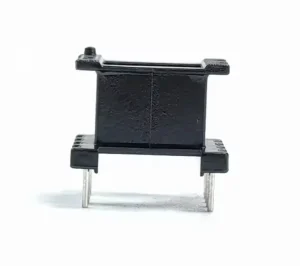
Introduction
Overview of Ferrite Core Bobbin in Transformer Applications
In transformer applications, ferrite core bobbin serves as crucial components that facilitate efficient energy transfer and electromagnetic performance. These bobbins are specifically designed to house ferrite cores, which are ceramic-like materials known for their high magnetic permeability and low electrical conductivity. The unique properties of ferrite cores make them ideal for transforming electrical energy from one voltage level to another with minimal losses.
Importance of Ferrite Core Bobbin in Enhancing Electrical Efficiency
Ferrite core bobbins play a pivotal role in enhancing electrical efficiency in transformers through several key mechanisms:
Magnetic Flux Concentration: The design of the bobbin ensures that the ferrite core efficiently concentrates magnetic flux, reducing leakage and enhancing the overall efficiency of the transformer.
Reduction of Eddy Currents: Ferrite materials inherently suppress eddy currents, which are a major source of energy loss in alternating current (AC) systems. By encapsulating the ferrite core within a bobbin, these losses are minimized, leading to improved efficiency.
Compact Design: The compact and standardized design of ferrite core bobbins allows for efficient assembly and integration into transformer windings, optimizing space utilization and reducing manufacturing costs.
In summary, ferrite core bobbins are integral to transformer technology, contributing significantly to the enhancement of electrical efficiency by maximizing magnetic flux concentration and minimizing energy losses. Their widespread use underscores their importance in modern electrical systems, supporting advancements in energy conservation and sustainable practices.
Functionality and Design of Ferrite Core Bobbin
Role of Ferrite Core Bobbin
Ferrite core bobbins serve a critical role in transformer and inductor applications, facilitating efficient electromagnetic performance and minimizing energy losses. The primary functions and design principles include:
Magnetic Flux Management: The bobbin securely houses the ferrite core, which is crucial for managing magnetic flux. It ensures that the flux lines are concentrated within the core, thereby reducing leakage and enhancing the transformer’s efficiency.
Insulation and Stability: Bobbins are designed to provide electrical insulation between windings and mechanical stability to the ferrite core assembly. This prevents short circuits and ensures reliable operation over the transformer’s lifespan.
Winding Configuration: The design of the bobbin includes features to facilitate the winding of coils around the ferrite core. This configuration optimizes the electromagnetic coupling between windings, improving overall transformer performance.
How Ferrite Core Bobbin Minimizes Energy Losses
Ferrite core bobbins contribute significantly to minimizing energy losses in transformers through several mechanisms:
Eddy Current Suppression: Ferrite cores have high resistivity and low electrical conductivity, which naturally suppresses the formation of eddy currents. When encapsulated within a bobbin, this property helps to minimize energy losses that occur due to circulating currents induced by alternating magnetic fields.
Reduced Hysteresis Losses: The magnetic properties of ferrite cores, such as their high magnetic permeability and low coercivity, lead to lower hysteresis losses. This phenomenon occurs as the core magnetization follows the alternating magnetic field without significant energy dissipation.
Optimized Magnetic Path: The bobbin’s design ensures a precise fit and alignment of the ferrite core, optimizing the magnetic path and reducing magnetic reluctance. This minimizes the energy required to magnetize the core during operation, improving overall efficiency.
In conclusion, ferrite core bobbins play a crucial role in transformer design by managing magnetic flux, providing insulation and stability, and optimizing winding configurations. Their integration significantly contributes to minimizing energy losses in electrical systems, enhancing efficiency, and supporting sustainable energy practices.
Material Characteristics and Manufacturing of Ferrite Core Bobbin
Analysis of Magnetic Properties
Ferrite core bobbins are constructed using ferrite materials, which exhibit specific magnetic properties essential for transformer applications:
High Magnetic Permeability: Ferrite materials possess high magnetic permeability, allowing them to efficiently concentrate magnetic flux within the core. This property is crucial for enhancing the transformer’s magnetic performance and reducing losses.
Low Electrical Conductivity: Ferrite materials have low electrical conductivity, which helps suppress eddy currents—localized circulating currents induced within the material by alternating magnetic fields. This characteristic minimizes energy losses and improves overall efficiency.
Manufacturing Processes
The manufacturing of ferrite core bobbins involves several specialized processes to ensure high quality and performance:
Material Preparation:
- Raw Material Selection: High-purity raw materials, including iron oxide and various oxides of other metals (such as manganese, zinc, and nickel), are selected based on their specific magnetic properties.
- Mixing and Forming: These raw materials are mixed and then pressed into the desired shape using molds or dies to form the ferrite core bodies.
Sintering:
- The formed ferrite core bodies undergo a sintering process at high temperatures (typically around 1000°C to 1300°C) in controlled atmospheres. This process sinters the particles together, forming a dense and homogeneous structure with the desired magnetic properties.
Machining and Finishing:
- After sintering, the ferrite core bodies may undergo machining processes such as grinding or cutting to achieve precise dimensions and surface finish.
- They are then inspected for quality and may receive additional surface treatments or coatings to enhance their performance and durability.
Assembly into Bobbins:
- The ferrite cores are assembled into bobbin structures, which are typically made from insulating materials such as plastics or resins. The bobbin design ensures proper alignment and insulation of the ferrite core within the transformer winding.
Key Technological Aspects in Production
Precision in Dimensional Control: Maintaining tight tolerances in the manufacturing process ensures consistent magnetic properties and mechanical fit within transformer assemblies.
Insulation and Stability: Bobbin materials must provide adequate electrical insulation to prevent short circuits between windings and mechanical stability to support the ferrite core under varying operational conditions.
Quality Assurance: Advanced testing and inspection techniques, such as magnetic flux density measurements and eddy current testing, ensure that ferrite core bobbins meet stringent performance standards for efficiency and reliability in transformer applications.
In essence, the production of ferrite core bobbins combines advanced materials science with precision manufacturing techniques to create components that optimize magnetic flux management and minimize energy losses in transformers. These technological advancements continue to drive improvements in transformer efficiency and performance across diverse industrial sectors.